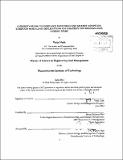| dc.contributor.advisor | Henry Birdseye Weil. | en_US |
| dc.contributor.author | Nath, Vivin | en_US |
| dc.contributor.other | System Design and Management Program. | en_US |
| dc.date.accessioned | 2013-01-23T19:46:11Z | |
| dc.date.available | 2013-01-23T19:46:11Z | |
| dc.date.copyright | 2012 | en_US |
| dc.date.issued | 2012 | en_US |
| dc.identifier.uri | http://hdl.handle.net/1721.1/76506 | |
| dc.description | Thesis (S.M. in Engineering and Management)--Massachusetts Institute of Technology, Engineering Systems Division, System Design and Management Program, 2012. | en_US |
| dc.description | Cataloged from PDF version of thesis. | en_US |
| dc.description | Includes bibliographical references (p. 116-119). | en_US |
| dc.description.abstract | Deregulation shaping the Electricity industry across the world is a systems challenge cutting across interdisciplinary fields of technology, economics, public policy, environment and sociology. Decision makers that shape tomorrow's policy and investors that invest in financial and technological developments in this industry need to rely on multiple decision models to make informed decisions. This thesis serves to provide one such decision model among many that could be used to understand the key dynamics shaping a highly complex industry. We employ "top-down" and "bottom-up" approaches to build system dynamics model in an attempt to distinguish between adoption and diffusion phenomenon, as a result benefiting from hybrid modeling techniques that combine structures from both models. The models are evaluated with wide range of scenarios to arrive at policy guidance and business model recommendations. The dynamic hypothesis arising from our system dynamics model points to declining marginal profits in a saturating market coupled with proliferation of competitors, over-estimation of demand and diminishing margins for Curtailment Service Providers (CSPs) in the long run. We propose recommendations to surmount these challenges. To tap the smaller commercial and residential markets, CSPs must extend its reach by partnering with composite channel partners, who in the long run could also play a vital role in demand generation. In the face of commoditization and disruptive innovations, CSPs would not be able to sustain their margins just by aggregating demand response (DR) capacity, they would need to reinvent themselves to become energy management firms providing integrated, automated turnkey energy services including energy efficiency services, risk management, planning, sourcing along with providing DR services. Taking a systems approach in evaluating demand-side technology, we further investigate environmental implications of DR by characterizing the carbon savings from DR. Our analyses revealed that the carbon savings from DR triggered load curtailment when calculated using system wide carbon intensities differ substantially from those calculated with locational carbon intensities. Locational carbon intensity captures the location and time-specific dynamics of electricity demand. We, therefore, recommend it is a better metric for evaluating total carbon savings from load curtailment, which could be used to devise carbon abatement policies and structure the electricity market design rules. Furthermore, adding a carbon price to the marginal cost equation could change the dispatch order of plants and thus align carbon abatement policies with load reduction schemes. | en_US |
| dc.description.statementofresponsibility | by Vivin Nath. | en_US |
| dc.format.extent | 131 p. | en_US |
| dc.language.iso | eng | en_US |
| dc.publisher | Massachusetts Institute of Technology | en_US |
| dc.rights | M.I.T. theses are protected by
copyright. They may be viewed from this source for any purpose, but
reproduction or distribution in any format is prohibited without written
permission. See provided URL for inquiries about permission. | en_US |
| dc.rights.uri | http://dspace.mit.edu/handle/1721.1/7582 | en_US |
| dc.subject | Engineering Systems Division. | en_US |
| dc.subject | System Design and Management Program. | en_US |
| dc.title | Understanding technology diffusion and market adoption through modeling : implications on strategy for demand-side energy firms | en_US |
| dc.type | Thesis | en_US |
| dc.description.degree | S.M.in Engineering and Management | en_US |
| dc.contributor.department | System Design and Management Program. | en_US |
| dc.contributor.department | Massachusetts Institute of Technology. Engineering Systems Division | |
| dc.identifier.oclc | 823591916 | en_US |
